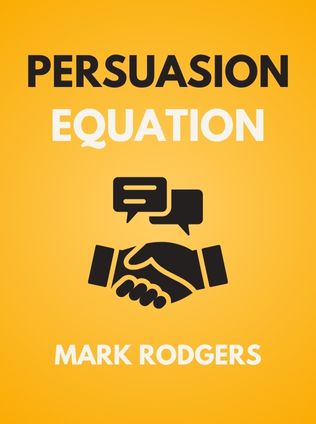
Persuasion Equation
The Subtle Science of Getting Your Way
By Mark Rodgers
Published 05/2015
About the Author
Mark Rodgers is a principal partner of the Peak Performance Business Group, dedicated to enhancing clients' persuasion abilities. A renowned speaker, Rodgers has conducted over 1,500 sales and persuasion workshops, averaging more than 200 presentations annually. He writes the Persuasion Matters blog and authored "Accelerate the Sale." His expertise in persuasive techniques is encapsulated in his book, "Persuasion Equation: The Subtle Science of Getting Your Way."
Main Idea
In "Persuasion Equation," Mark Rodgers delves into the intricate art of persuasion, blending research with practical applications. The book aims to equip readers with the skills to influence decisions effectively, whether it's for securing a promotion, making a sale, or rallying support for a new idea. Rodgers introduces the persuasion equation—a combination of factors that expedite agreement. By understanding what drives people to say "yes," mastering credibility, adapting to personality differences, and utilizing strategic language, readers can transform their persuasive efforts into success stories.
Table of Contents
- Persuasion Fundamentals
- Setting Your Persuasion Priority
- Persuasion Precepts
- Decision Making Heuristics and Biases
- Targets, Technology, and Tactics
- Building Your Business Case
- The Credibility Crucible
- Power Language
- Persuasive Processes
- Persuasion 360
- Persuasion 911
- The Psychology of Self-Persuasion
Persuasion Fundamentals
Persuasion is often misunderstood as coercive or manipulative. However, true persuasion is about ethically winning the heart and mind of your target. It involves two primary roles: getting someone to say "yes" to your offer or request and dissuading them from taking undesirable actions. To thrive in any professional setting, mastering both roles is crucial. Persuasion helps you get someone to willingly do something or avoid harmful actions. The essence of persuasion lies in doing it for the right reasons and in the right manner.
Rodgers emphasizes that persuasion should be conducted ethically. He defines persuasion as "ethically winning the heart and mind of your target." The term "ethically" signifies honesty and integrity, "winning" means gaining agreement, "heart" refers to emotional buy-in, "mind" signifies logical buy-in, and "target" is the specific person you aim to persuade. By adhering to these principles, persuasion becomes a positive and impactful tool in both professional and personal contexts.
Setting Your Persuasion Priority
Identifying your persuasion priority is the first step toward effective persuasion. This involves pinpointing who you want to say "yes" and what you want them to agree to. Your priority must be meaningful, significant, realistic, and others-oriented. Wildly persuasive people balance assertiveness, empathy, communication, tenacity, and resilience. Asking yourself who you want to persuade and why helps clarify your goals and streamline your persuasive efforts.
Rodgers introduces four criteria for setting persuasion priorities:
- Meaningful: The priority must be important to you and your organization.
- Significant: The priority should be large enough to make a difference.
- Realistic: The priority should be attainable.
- Others-Oriented: The priority should improve the condition of others.
For example, if your goal is to bring a new product to market, your persuasion priority might be to convince the product development team to support your idea. By ensuring that this priority meets the four criteria, you set the stage for a successful persuasive effort.
Persuasion Precepts
Three foundational ideas underpin persuasive efforts: reciprocity, enlightened self-interest, and congruency. Reciprocity involves a cooperative exchange, where mutual benefits are sought. "Enlightened self-interest" means pursuing actions beneficial to yourself, your target, and the larger whole. Congruency requires aligning external actions with internal beliefs. By adhering to these precepts, you can foster a persuasive environment where everyone feels valued and understood.
Reciprocity
Reciprocity is the linchpin of persuasion. It involves the give-and-take of human exchange, where mutual benefits are sought. Establishing a mindset of reciprocity requires actively doing things for others and being willing to accept assistance. By fostering a cooperative environment, you maximize your chances of persuasive success.
Enlightened Self-Interest
Enlightened self-interest involves pursuing actions that are beneficial to you, your target, and the larger community. When an action positively impacts all parties involved, it becomes easier to persuade others to support it. By appealing to the enlightened self-interest of your target, you increase the likelihood of gaining their agreement.
Congruency
Congruency requires aligning your external actions with your internal beliefs. To be convincing, you must first be convinced of the value and ethicality of your proposal. When your actions and beliefs are congruent, your persuasive efforts become more authentic and effective.
Sign up for FREE and get access to 1,400+ books summaries.
You May Also Like
The Subtle Art of Not Giving a F*ck
A Counterintuitive Approach to Living a Good Life
By Mark MansonRich Dad Poor Dad
What the Rich Teach Their Kids About Money - That the Poor and Middle Class Do Not!
By Robert T. KiyosakiHow To Win Friends and Influence People
The All-Time Classic Manual Of People Skills
By Dale CarnegieQuiet: The Power of Introverts
The Power of Introverts in a World That Can't Stop Talking
By Susan Cain



















